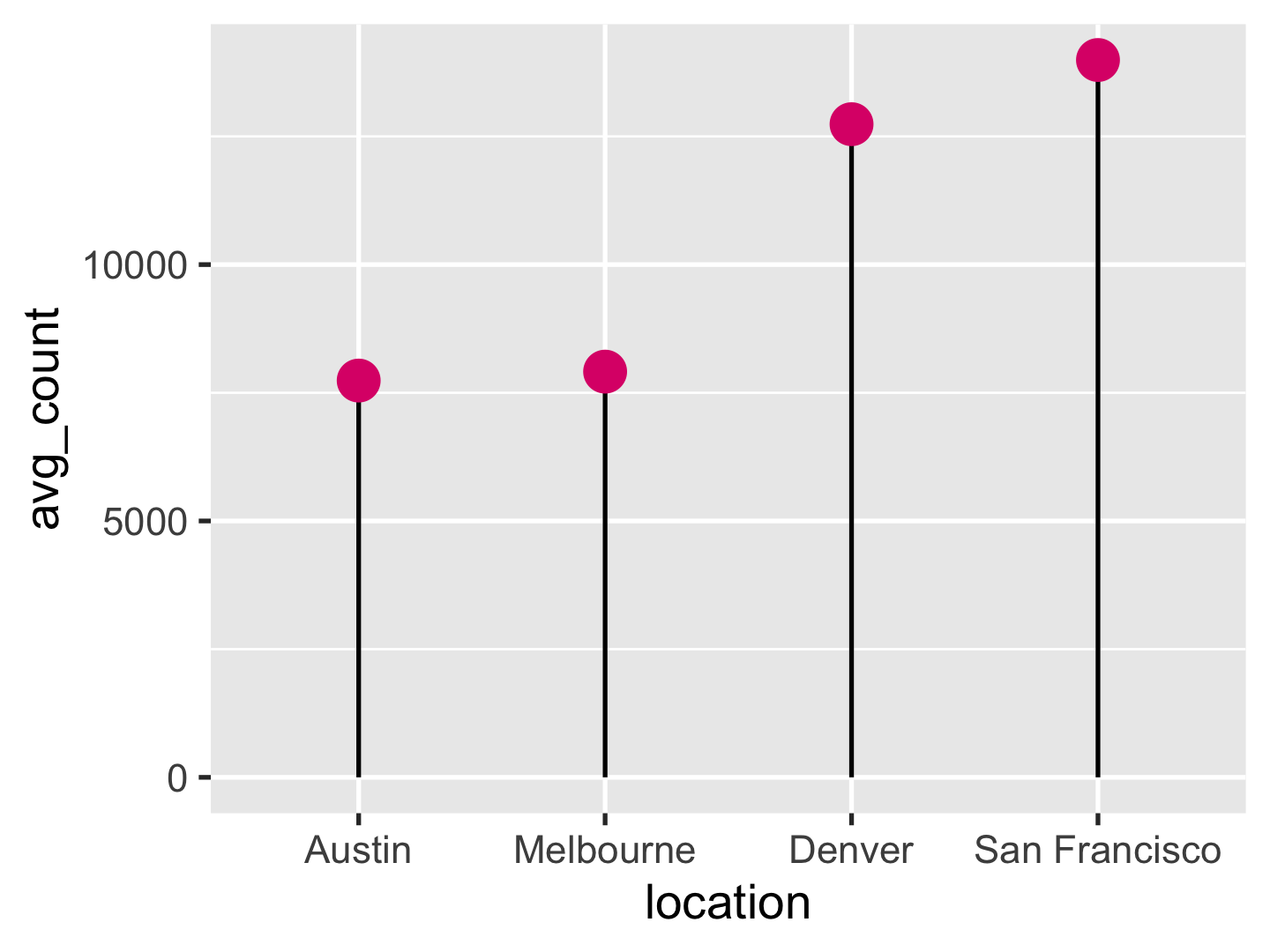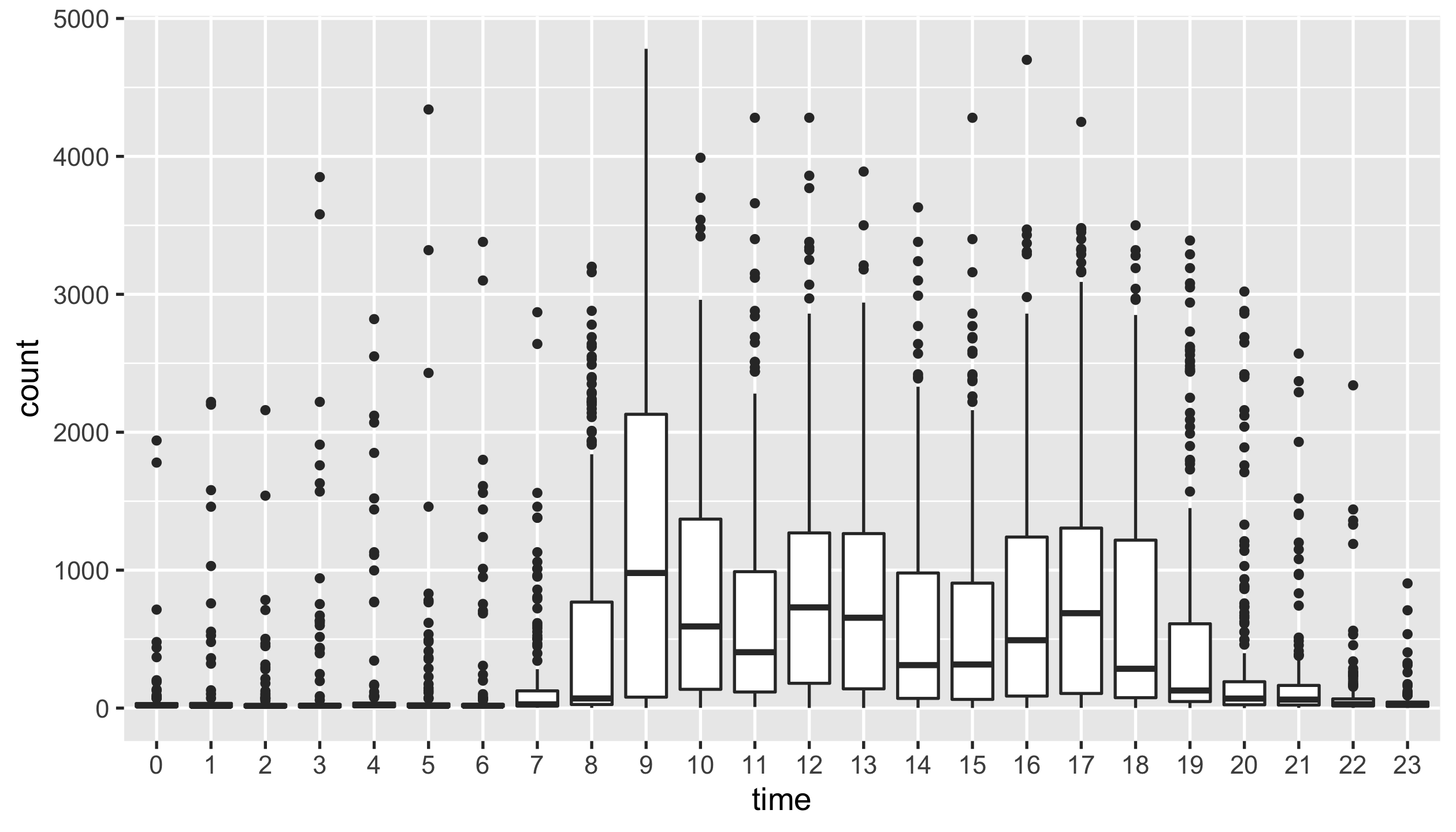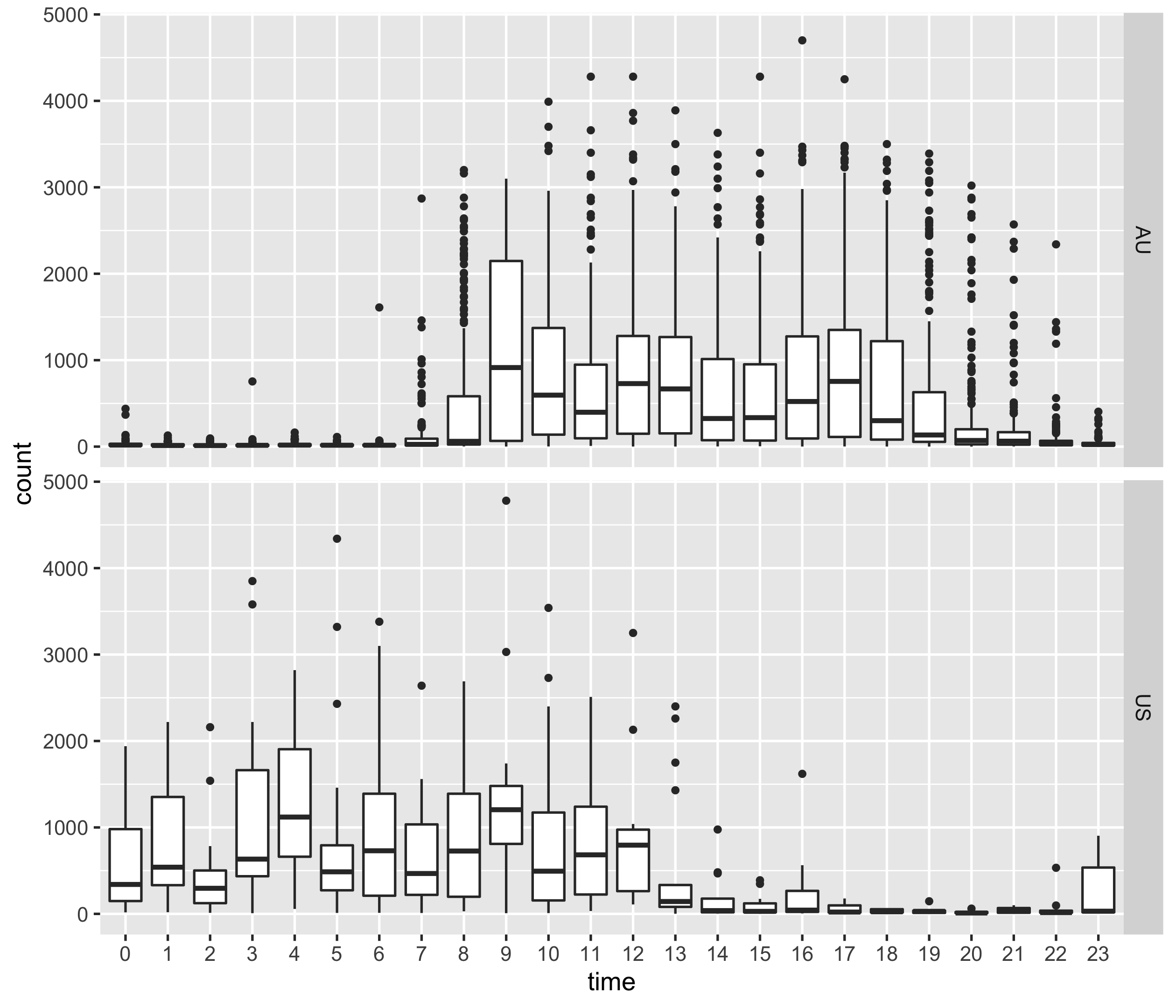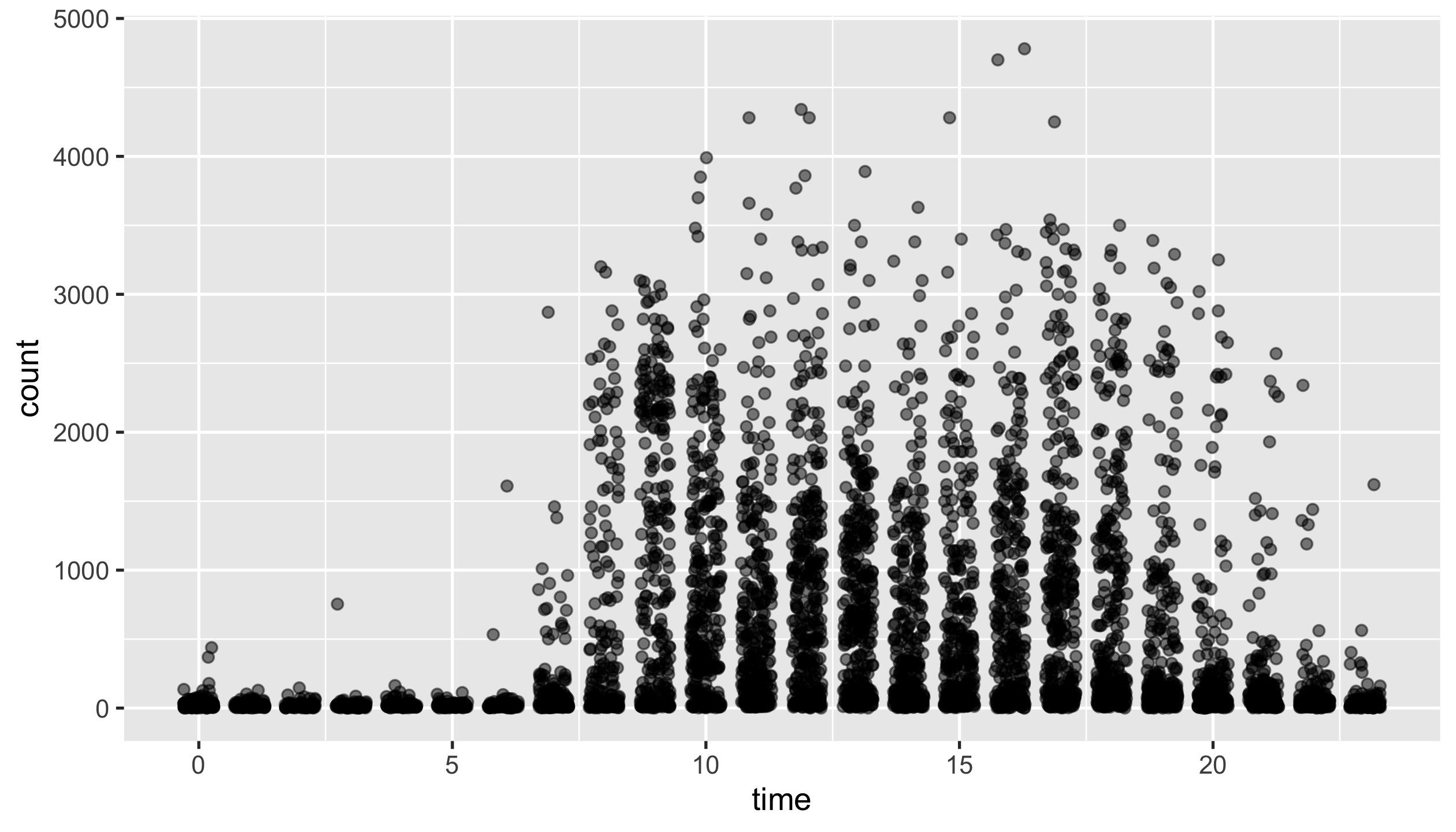Lab 05
This lab exercise is due 23:59 Monday 26 April (NZST).
- You should submit an R file (i.e. file extension
.R) containing R code that assigns the appropriate values to the appropriate symbols. - Your R file will be executed in order and checked against the values that have been assigned to the symbols using an automatic grading system. Marks will be fully deducted for non-identical results.
- Intermediate steps to achieve the final results will NOT be checked.
- Each question is worth 0.2 points.
- You should submit your R file on Canvas.
- Late assignments are NOT accepted unless prior arrangement for medical/compassionate reasons.
In this lab exercise, you are going to work with two data sets:
step-count.csv that contains Dr Wang’s hourly step counts, and
location.csv with cities where she was in 2019. You shall use the
following code snippet (and include them upfront in your R file) to
start with this lab session:
library(lubridate)
library(tidyverse)
step_count_raw <- read_csv("data/step-count/step-count.csv",
locale = locale(tz = "Australia/Melbourne"))
location <- read_csv("data/step-count/location.csv")
step_count <- step_count_raw %>%
rename_with(~ c("date_time", "date", "count")) %>%
left_join(location) %>%
mutate(location = replace_na(location, "Melbourne"))
step_count
#> # A tibble: 5,448 x 4
#> date_time date count location
#> <dttm> <date> <dbl> <chr>
#> 1 2019-01-01 09:00:00 2019-01-01 764 Melbourne
#> 2 2019-01-01 10:00:00 2019-01-01 913 Melbourne
#> 3 2019-01-02 00:00:00 2019-01-02 9 Melbourne
#> 4 2019-01-02 10:00:00 2019-01-02 2910 Melbourne
#> 5 2019-01-02 11:00:00 2019-01-02 1390 Melbourne
#> 6 2019-01-02 12:00:00 2019-01-02 1020 Melbourne
#> 7 2019-01-02 13:00:00 2019-01-02 472 Melbourne
#> 8 2019-01-02 15:00:00 2019-01-02 1220 Melbourne
#> 9 2019-01-02 16:00:00 2019-01-02 1670 Melbourne
#> 10 2019-01-02 17:00:00 2019-01-02 1390 Melbourne
#> # … with 5,438 more rows
Suppose that you have created an Rproj for this course. You need to
download step-count.csv
here
and location.csv
here,
to data/step-count/ under your Rproj folder.
- You’re required to use relative file paths
data/step-count/step-count.csvanddata/step-count/location.csvto import these data. NO marks will be given to this lab for using URL links or different file paths. - NO marks given to the question, in which you apply
theme()and aesthetics other than what I instruct to the plot.
Question 1
Calculate average daily step counts for every location, from
step_count.
You should end up with a tibble called city_avg_steps.
HINTS
- two
summarise()needed.
city_avg_steps
#> # A tibble: 4 x 2
#> location avg_count
#> <chr> <dbl>
#> 1 Austin 7738.
#> 2 Denver 12738.
#> 3 Melbourne 7912.
#> 4 San Francisco 13990.
Question 2
Create a lollipop plot to display average daily steps at each location from low to high.
You should end up with a ggplot called p1, with
- point:
size = 4andcolour = "#dd1c77".
p1

Question 3
Add two new columns to the step_count:
time: hour of the day in factor.country: whenlocationis Melbourne, set values with"AU"; otherwise"US".
You should end up with a tibble called step_count_time.
step_count_time
#> # A tibble: 5,448 x 6
#> date_time date count location time country
#> <dttm> <date> <dbl> <chr> <fct> <chr>
#> 1 2019-01-01 09:00:00 2019-01-01 764 Melbourne 9 AU
#> 2 2019-01-01 10:00:00 2019-01-01 913 Melbourne 10 AU
#> 3 2019-01-02 00:00:00 2019-01-02 9 Melbourne 0 AU
#> 4 2019-01-02 10:00:00 2019-01-02 2910 Melbourne 10 AU
#> 5 2019-01-02 11:00:00 2019-01-02 1390 Melbourne 11 AU
#> 6 2019-01-02 12:00:00 2019-01-02 1020 Melbourne 12 AU
#> 7 2019-01-02 13:00:00 2019-01-02 472 Melbourne 13 AU
#> 8 2019-01-02 15:00:00 2019-01-02 1220 Melbourne 15 AU
#> 9 2019-01-02 16:00:00 2019-01-02 1670 Melbourne 16 AU
#> 10 2019-01-02 17:00:00 2019-01-02 1390 Melbourne 17 AU
#> # … with 5,438 more rows
levels(step_count_time$time)
#> [1] "0" "1" "2" "3" "4" "5" "6" "7" "8" "9" "10" "11" "12"
#> [14] "13" "14" "15" "16" "17" "18" "19" "20" "21" "22" "23"
step_count_time %>%
filter(country == "US")
#> # A tibble: 323 x 6
#> date_time date count location time country
#> <dttm> <date> <dbl> <chr> <fct> <chr>
#> 1 2019-01-15 03:00:00 2019-01-15 8 Austin 3 US
#> 2 2019-01-15 05:00:00 2019-01-15 355 Austin 5 US
#> 3 2019-01-15 06:00:00 2019-01-15 1800 Austin 6 US
#> 4 2019-01-15 07:00:00 2019-01-15 261 Austin 7 US
#> 5 2019-01-15 11:00:00 2019-01-15 1240 Austin 11 US
#> 6 2019-01-15 12:00:00 2019-01-15 795 Austin 12 US
#> 7 2019-01-15 13:00:00 2019-01-15 206 Austin 13 US
#> 8 2019-01-15 14:00:00 2019-01-15 481 Austin 14 US
#> 9 2019-01-16 01:00:00 2019-01-16 2220 Austin 1 US
#> 10 2019-01-16 02:00:00 2019-01-16 711 Austin 2 US
#> # … with 313 more rows
Question 4
Create a boxplot that visualises the distribution of hourly step counts.
You should end up with a ggplot called p2, with
outlier.size = 1.
p2

Question 5
Facet p2 by countries on rows.
You should end up with a ggplot called p3, with
outlier.size = 1.
p3

Question4fun (NO marks)
This is a challenging question, where you need to have solid understanding about time zones in R.
Your instructor wanders like a ghost during night times in US, due to time zone issues. To correct these spooky behaviours, time zones have to be adjusted to the local time zone.
Create a jitter plot to demonstrate the corrected hourly step counts, with
position = position_jitter(0.3, seed = 220)andalpha = 0.5
HINTS
force_tz()andwith_tz()from {lubridate} are useful.
